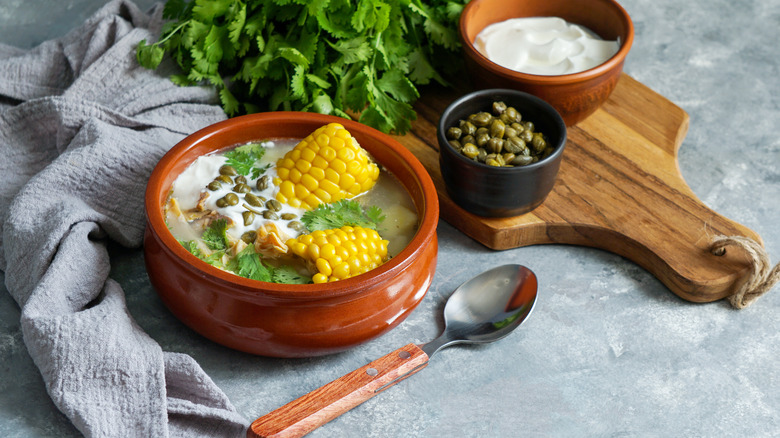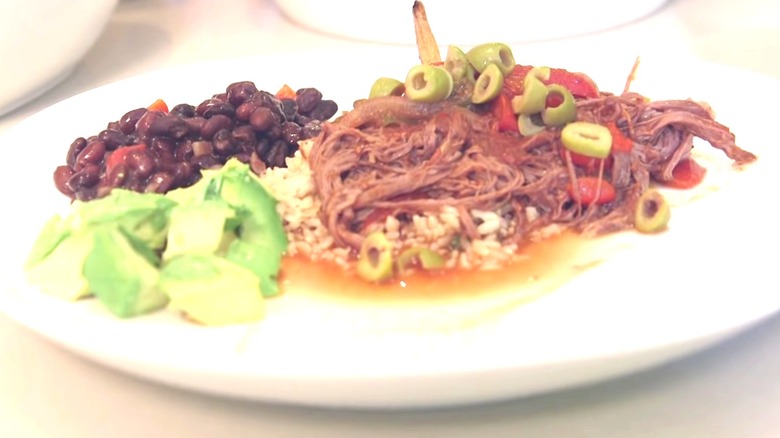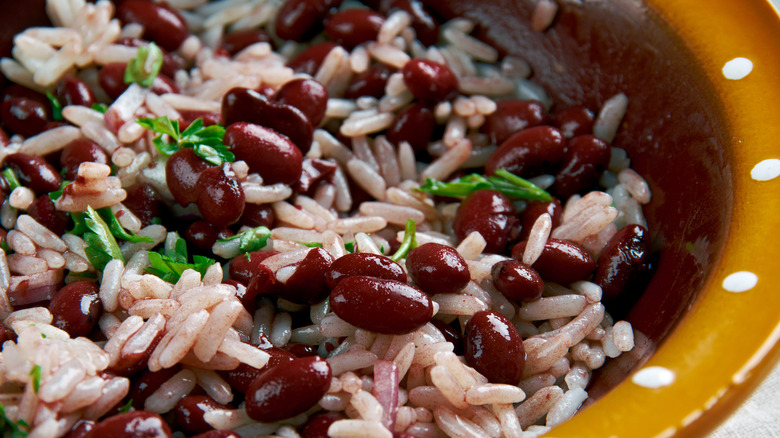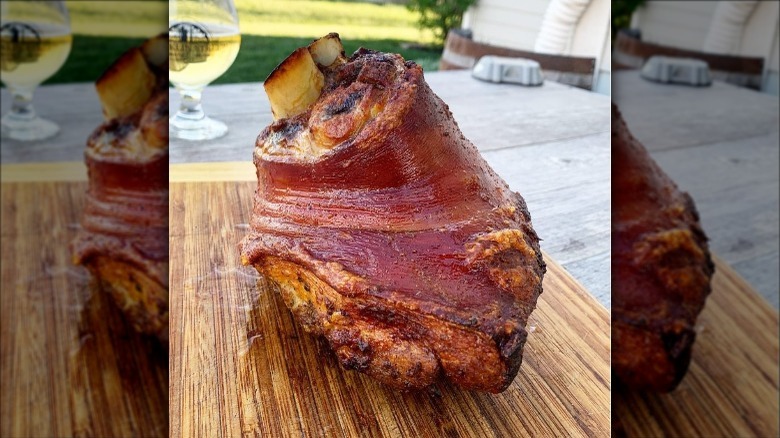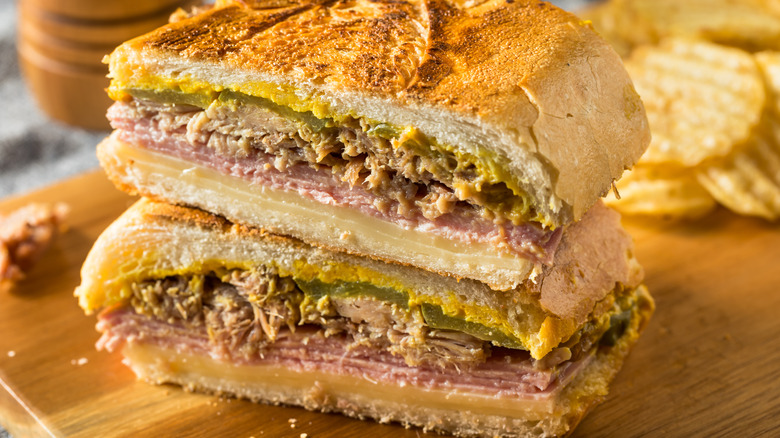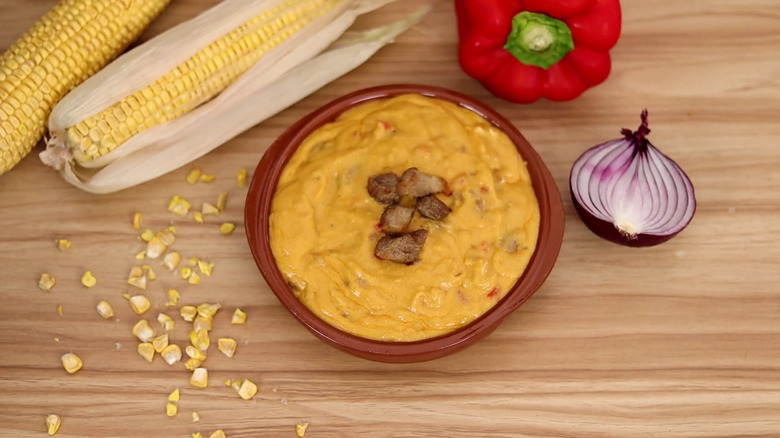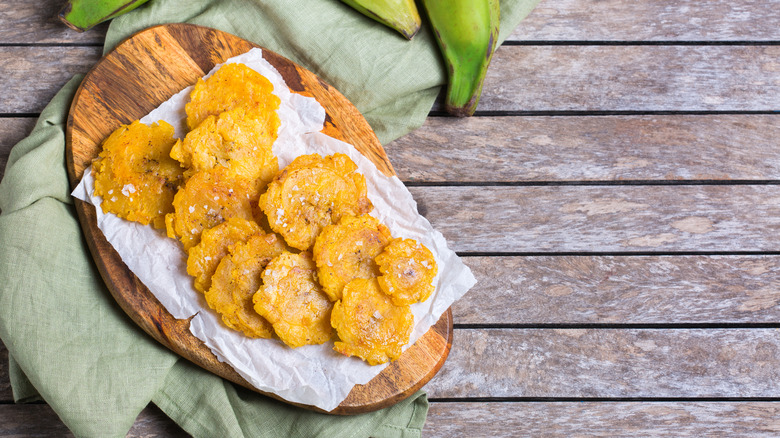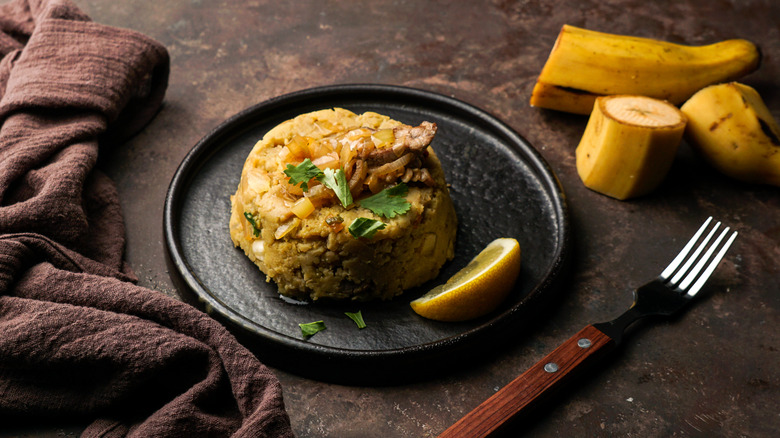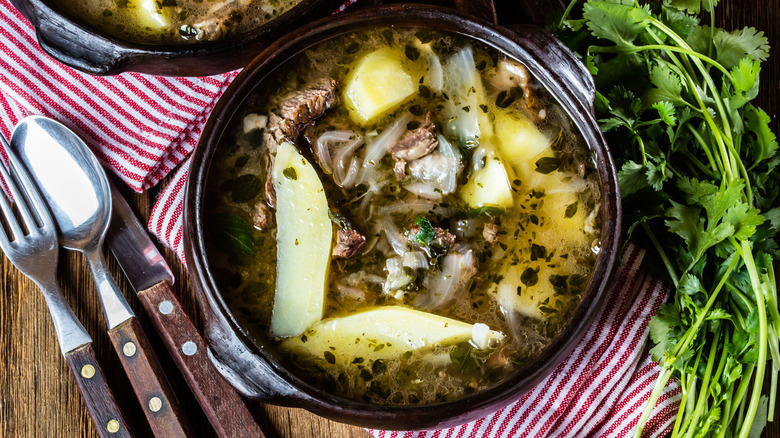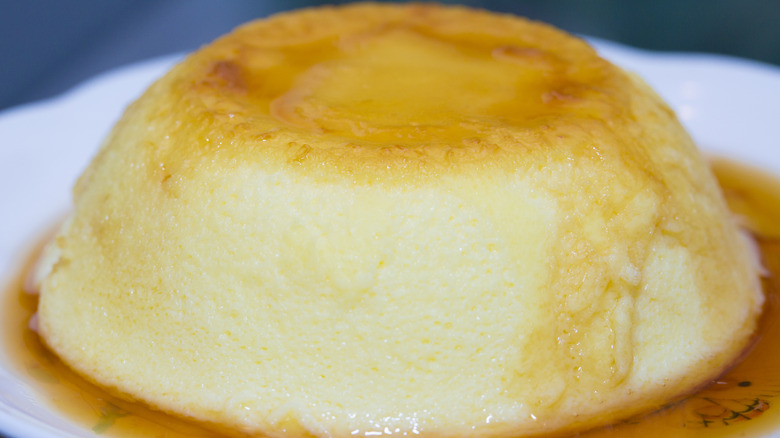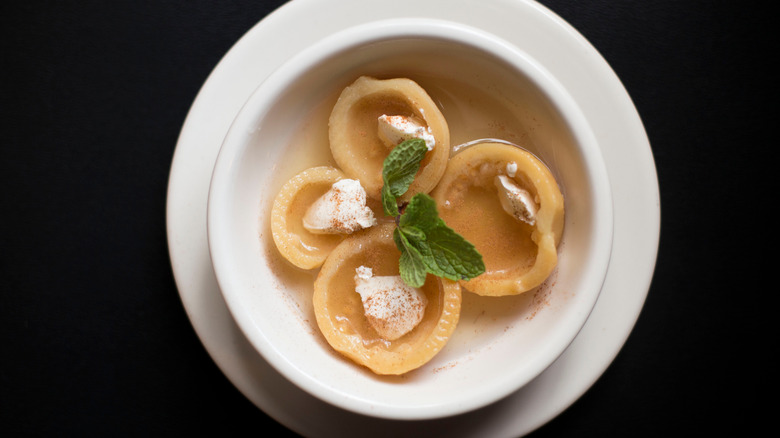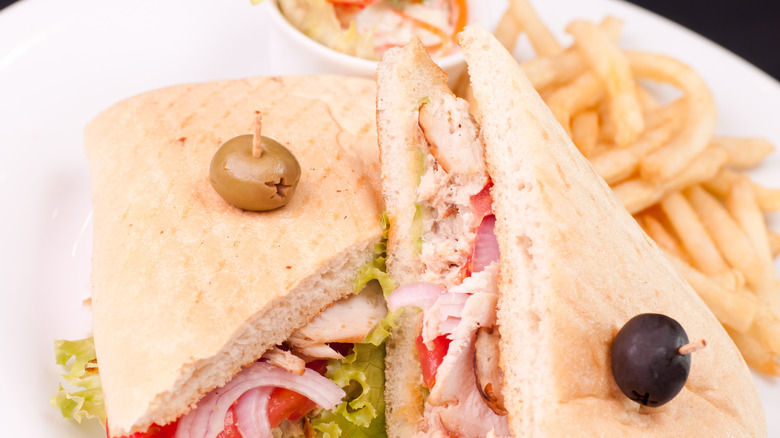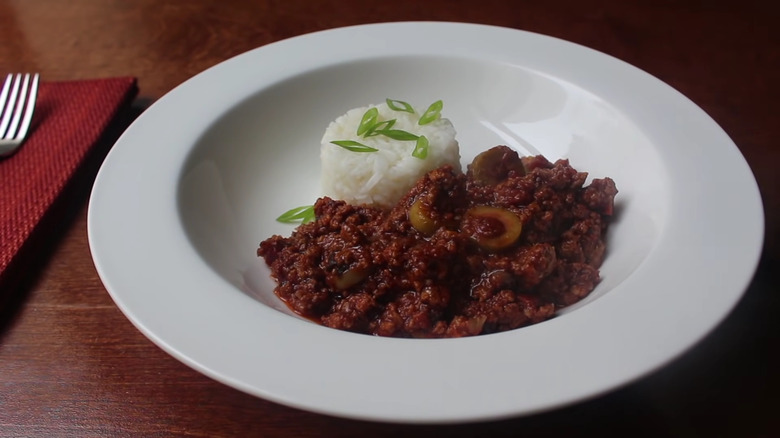Why You Need To Try These Traditional Cuban Foods Before You Die
We may receive a commission on purchases made from links.
As a country, Cuba has been home to many different types of cultures and communities, so there's little surprise that contemporary Cuban culture is made up of facets from each. Cumulatively, they form a composite — and together, the sum of those parts creates its own culture, wholly and uniquely Cuban. As is so frequently the case, food has been a way to chart the evolution of Cuba on a societal basis. It's not a dormant process, either, and elements like government policy and food availability in Cuba have continued to contribute to it, even to this day.
Despite this process of constant culinary evolution, there remain some quintessentially Cuban foods — traditional and celebrated dishes that have stood the test of time. Due to Cuba's multicultural history, these dishes are typically an exciting and unique mixture of flavors, textures, and aromas which captivate the palate like little else. Combined with heaps of Cuban history served alongside traditional Cuban foods, these dishes are a must-try for any self-proclaimed foodie.
Ropa vieja
Ropa vieja has the distinct honor of being Cuba's national dish (via Salon). The proliferation of ropa vieja appears in various guises throughout Spain, the Caribbean, and Latin America. Per the food site Revolución de Cuba, its ubiquity has led many to conclude that the dish originated in Sephardic Jewish communities on the Iberian Peninsula, and was then spread by Spain's colonizing forces. This is a notion supported by evidence: The first written record of ropa vieja in Cuba can be found in an 1857 cookbook titled "Nuevo Manual del Cocinero Cubano y Español" (via Amigo Foods). While the traditional Spanish version of ropa vieja places great prominence on garbanzo beans, Cuba's national dish highlights boiled and shredded beef. The Cuban version of the dish is also distinctly and deliciously flavored by way of its inclusion of traditional Cuban sofrito, a mixture of fried alliums, peppers, and tomatoes (via The Jerusalem Post).
Although ropa vieja is Cuba's national dish in name, over the past few decades it has been infrequently consumed by the Cuban populace. In 1963, the Cuban government introduced a law that made it illegal for farmers to kill a cow without a governmental sign-off. In 2021, Reuters reported an easing of this ban in tandem with the government's attempt to bolster Cuba's agricultural industry, leading many to hope that Cuba's national dish will become accessible once again.
Arroz con moros y cristianos
Translated as "rice with Moors and Christians" in English, arroz con moros y cristianos consists of white rice cooked with sofrito and black beans (via Salon) — a combo that is by no means exclusive to Cuba. It's a pairing that's popular worldwide and has historically been enjoyed by disparate societies for thousands of years, according to the non-profit Oldways Nutrition Exchange. As Salon noted in their write-up of congrí — the general food category to which moros y cristianos belongs — the name of this traditional Cuban dish does not refer to Cuba. Rather, it references the conflict between Muslims and Christians that occurred in Iberia up until (and during) the Reconquista, a campaign helmed by European Christian forces in the 1500s to oust the Moors from Spain.
Due to the dish's evident ties to Spanish history, it is commonly thought that moros y cristianos was introduced to Cuba during the Spanish colonization of the country, per Salon. However, moros y cristanos has come to infer more than just a snippet of Spanish history. According to academic and author Nieves Pascual Soler, who wrote about the origins of moros y cristianos in the scholarly anthology Memory Frictions in Contemporary Literature, over time the dish has come to serve as a metaphor for Cuban society's understanding of race. As such, the dish forms a cornerstone of both Cuban socio-cultural history and cuisine, making it an accessible entry point into the country's historic and contemporary culture.
Lechón asado
Traditional Cuban lechón asado, or suckling pig, involves a distinct mixture of global flavors and cultures. During the preparation phase for making lechón asado, the pig itself is marinated in mojo, a type of sauce thought to have been created in the Canary Islands, as noted by the culture website Gran Canaria Info. While roasting the meat, banana leaves (the plant was introduced to Cuba and the rest of the Caribbean around the 16th century) are traditionally used as a material to cover the pig itself during the roasting process (via The New York Times).
Consequently, lechón asado not only plays an important part in Cuban festivities but is a symbolic culinary testament to the blending of numerous disparate societies, which formed contemporary Cuba's cultural identity. In that vein, lechón asado is a must-try dish for anyone who wants to understand how combining global culinary practices creates a meal that embodies an entire country.
Sandwich cubano
Undoubtedly Cuba's most famous and widely tried dish, the pressed sandwich known as the cubano (or Cuban sandwich) is also its most contested, with opinions split over its origins. Until recently, two places staked a claim to the Cuban sandwich: the Florida cities of Tampa and Miami.
Out of the two, many believe Tampa has the most legitimate claim. Speaking with Thrillist in 2016, food chemist Jorge Astorquiza explained that Cuban immigrants who ended up in Tampa — many of whom ended up working for the booming tobacco industry during the 19th century — were the most likely group to first to call the cubano by its current name. (Per Thrillist, the sandwich itself had Cuban origins, but was invented as a cheap lunch for these workers.) However, this has been contested by others who believe Miami to be the birthplace of the cubano, especially after Tampa's city council renamed the sandwich the "Historic Tampa Cuban Sandwich" in 2012, per NPR.
While Miami and Tampa have long feuded over the sandwich's origins, recent research conducted by University of South Florida librarian Andy Huse stands to prove them both wrong. As Huse told the Tampa Bay Times in 2021, it's possible that the sandwich was a delicacy in Cuba long before it made it to the U.S., suggesting that the specific blend of ingredients used to make the sandwich — ham, cheese, pickles, pork, and mustard — were specific to Cuba, and not contributed by other contemporaneous immigrant populations from Germany, Italy, and Spain in the early 20th century.
Tamal en cazuela
Tamales are a Mesoamerican specialty made with corn stuffed with filling (such as meat) and then steamed in a corn husk. It is thought that the dish was created by Indigenous communities in what we now know as modern-day Mexico and Guatemala, and could have originated around 10,000 years ago as reported by food writer and author Daniel Hoyer in his book "Tamales". In the millennia since, the tamale's popularity has only grown with it being consumed across South America, Central America, and North America, as well as in the Caribbean. Indeed, global packaged tamale sales rose by 4.72% in 2021 alone, according to a report released by the market research company Technavio (via PR Newswire).
Consequently, many variations of the tamale have developed over time — including one undoubtedly unique to Cuba. Known as the tamal en cazuela, the dish varies from other traditional Latin American tamale-centric meals in two key ways. First, the filling is not found in the center — instead, it's mixed in with the dough (via the Los Angeles Times). Second, the typical tamal en cazuela is not steamed inside a husk or leaf, but rather cooked on top of the stove and stirred in a similar manner to porridge or polenta.
Tostones
Plantains — which grow exceedingly well in Cuba's climate — rapidly became a dietary stalwart and are used to complement a number of dishes or eaten as standalone snacks (via Global Foodways). The most popular of these snacks are tostones, made from green, unripe plantains that have been sliced and fried. These fried discs are then flattened before going back into the pan for a second round of basking in another immersive dip in crackling oil, creating a satisfying, crunchy in your mouth.
Because of their simplicity, tostones — and the similar yet sweeter maduros, or fried sweet plaintains — form a vital part of Cuban culture for those living in the diaspora. This is because the relatively simple process of prepping and cooking tostones, compared to other Cuban dishes, makes them one the most accessible, authentically Cuban foods to make at home. It also provides many households with a gateway into the cuisine in general. For these very same reasons tostones frequently feature in diasporic Cuban restaurants around the world as highlighted in the book "Cuba: Idea of a Nation Displaced."
Fufu de plátano
As with many countries located in the Caribbean (and in the Western hemisphere in general), Cuba was immensely altered by the transatlantic slave trade. New people, cultures, and produce shaped every facet of Cuban identity — and the cuisine was no exception, according to the Oxford Research Encyclopaedia of Latin American History. Consequently, many dishes that form an integral part of Cuba's culinary backbone have their origins in West Africa and the communities from which many of the Caribbean's new inhabitants were enslaved (via The New York Times). Perhaps the most prevalent of these is fufu de plátano.
In Central and Western Africa, the term fufu is used to describe a dish comprised of boiled, pounded vegetables that have then been shaped into balls. Usually, the ingredients needed to make fufu de plátano come from carbohydrate-rich produce such as yams, yielding dough-like results (via Britannica). In Cuba, yams were swapped out for the ubiquitous plantain to create a delicious and filling dish that forms a large part of Cuban cuisine. In that regard, fufu de plátano has direct links to West Africa in both name and substance.
Ajiaco cubano
Ajiaco cubano is a dish that can be traced directly back to one of Cuba's Indigenous populations, the Taíno. Cooked over a fire in pots, the original version of ajiaco was a stew, built from a broth base of native tubers and vegetables, and seasoned with a violently spicy chili. According to Smithsonian magazine, this version of ajiaco soon evolved to incorporate meat introduced by Spanish colonizers, with pork and beef replacing native animal proteins such as iguanas and turtles.
This was only the first alteration to be made. With each and every wave of immigration — forced or otherwise — ajiaco evolved. Plantains and yams were added when enslaved West Africans were forcibly brought to the island. Later, Chinese and Arab immigrants brought spices that have since been used to flavor the dish, as chef, food writer, and beloved media personality Anthony Bourdain highlighted in a Season 6 episode of his show "Parts Unkown."
The adaptability of ajiaco is what has allowed the dish to imprint itself in Cuban culture. For example, when the government-controlled cattle slaughter ajiaco could be made with pork, or when trade embargos made certain spices hard to access, others could be swapped in. Per Smithsonian magazine, the dish's accessibility, resilience and multiple cultural influences have led many to use it as a direct metaphor for the country itself, making it an absolute essential for anyone interested in Cuba's culture to try it.
Flan de leche
There aren't many more universally adored desserts than flan de leche, a ubiquitous dessert found in kitchens and menus across the globe. The origins of flan have generally been attributed to the Roman Empire, where flan was initially prepared as a savory dish, per COCINA. Before the fall of Rome, culinary minds of antiquity eventually discovered that flan could be sweetened with both honey and caramelized sugar, creating a flavor profile similar to the one we enjoy today.
Flan de leche was brought to Latin America and the Caribbean by Spanish colonizers in a more updated form, with versions of the dessert featuring citrus-infused flavoring and the implementation of almonds. (According to COCINA, this is largely thanks to the piquant influence of Spain's Moor population). Eventually, Cuban cooks developed their own unique spin on flan due to the limited availability of fresh milk, as well as access to ovens.
In lieu of both of these obstacles, Cuban cooks instead swapped in evaporated milk (which is unsweetened) or condensed milk (which is sweetened) and used a bain-marie, rather than a stove, to complete the cooking process. As a result, Cuba's flan de leche is generally considered richer than its counterparts in other countries (via Repeating Islands).
Casquitos de guayaba
Thought to have originated in Peru, guava is an extremely popular fruit that has historically been used both as both food and medicine, according to the American Indian Health and Diet Project website. In Cuba, the most famous use of this pre-Columbian fruit is as an ingredient for the dessert casquitos de guayaba. As Saveur noted in a 2022 exploration of the dish, preparation for the guava-based dish usually features the fruit being halved, peeled, and boiled in a mixture of water and sugar until soft. The guava is then served alongside a syrup produced during the cooking process, along with cream cheese.
While Cuba's climate is uniquely suited to growing and cultivating guava, production of the fruit is severely curtailed due to the limited importation of machinery, an economic embargo implemented by the U.S. in 1959 (via NBC News). According to the BBC, this has significantly impacted the way farmers are able to harvest and process produce, essentially forcing Cubans to rely on manual labor rather than machines — and for guava, in particular, allowing for the fruit to go uncollected, resulting in lost profits for agricultural workers.
The Elena Ruz
As The New York Times wrote in 2021, Elena Ruz Valdez-Fauli — the namesake of the sandwich known widely as the Elena Ruz — was a socialite from Havana who was known to frequent El Carmelo Restaurant late at night. According to her daughter, Margarita Ulacia, her mother favored an off-menu request considered so strikingly unusual by El Carmelo's staff that it soon became a cult classic. Her specific sandwich order consisted of turkey, cream cheese, and strawberry jam bookended by two slices of soft medianoche bread — one that Cuban-American restaurant owner Antonio "Bobo" Llizo told NYT has since become "an icon of Cuba."
After Ruz requested El Carmelo's owner put the sandwich on their official menu, its reputation spread, achieving a level of fame throughout the country. Per The New York Times, the sandwich was subsequently brought to the U.S. by immigrants following the Cuban revolution in 1959. The Elena Ruz is still a hallmark of Cuban culture and is featured on the menus of many famous Cuban-American eateries. As chef Daniel Figueredo joked to The New York Times: "Not having it [on the menu] would kind of remove your Cuban card."
Yuca con mojo
Despite being native to Brazil, yuca, otherwise known as cassava, is used extensively in both Latin American and Caribbean cuisines, according to Mexican chef Gabriela Cámara (via Masterclass). An extremely versatile vegetable, yuca can be prepared in a variety of ways. Due to its mild, companionable taste, yuca is frequently served with flavorful dips — which in Cuba most often take the form of mojo, the same tangy, sour sauce that is used to marinade lechón asado.
Historically, yuca is a food fraught with baggage. The food itself was a staple for enslaved Africans who were forced to labor on the island's sugar plantations, according to a 2002 article published in the New West Indian Guide, a scholarly journal. Following Cuba's revolution in 1959, the Cuban government sought to abolish all racial and class-based differences, with Cuba's then-newly appointed leader, Fidel Castro, citing that all were equally Cuban. This led to previously stigmatized foods — such as yuca, rice and beans, and plantains — rapidly integrating into the national diet. As of this writing, these very same foods form the backbone of Cuban cuisine and must be tried — especially if you are looking to understand and experience the fundamental, day-to-day flavors that define Cuba's cuisine.
Picadillo
Picadillo is another stew held near and dear by many Cuban citizens. Made from ground beef, tomatoes, raisins, and olives, the dish satiates a number of different flavor profiles in a single, filling mouthful. For this very reason, the dish is synonymous with comfort, according to Cuban-American food writer Betty Cortina. "Picadillo has a sentimental resonance," Cortina explained about the cultural resonance of picadillo in a 2014 interview with The New York Times. "Everyone who is of Cuban descent has a recipe for it, and each one of those is the most authentic. It's a comfort food, probably the most consummate example of one in Cuban cuisine."
Though versions of picadillo — a dish that has roots in Spain — can be found throughout Latin America, Cuban picadillo is unmistakable in its distinctiveness. This is due to its specific blend of ingredients mentioned above (via NYT). While traditionally eaten with rice, picadillo is incredibly versatile — especially when it's used as a filling for empanadas, or as a Cuban take on the messy mince sandwich known as the Sloppy Joe, per CBS News.
Guava mandelbrot
According to Tablet magazine, Jewish connections to Cuba have been traced all the way back Christopher Columbus' original voyage that began in 1492. Since then, the Jewish Cuban population became well-established, growing throughout the 19th century and the early part of the 20th. However, the vast majority of Jewish Cubans departed Cuba after the island's revolution in 1959. (In 2021, NPR estimated that only 1200 Jewish Cubans remain on the island.) This exodus resulted in the growth of Jewish-Cuban culture in areas outside of Cuba — specifically in South Florida and in metropolitan areas like Miami.
Fortunately, Cuba's own unique Jewish-Cuban culture has not been lost despite this decline in population. As reported by The New York Times, the vast majority of Jewish-Cubans still living in Cuba can be found in Havana. Here, the blending of these two cultures is exemplified through food, where Jewish classics are made with Cuban products.
The most prominent of these is mandelbrot, a twice-baked cookie that is made with almonds and has a similar texture to biscotti (per Michigan Daily). This classic Jewish dessert has been updated through the addition of one of Cuba's most prolific and favored fruits, guava, creating a cookie that upholds Jewish heritage whilst also satisfying the Cuban population's notorious sweet tooth.
